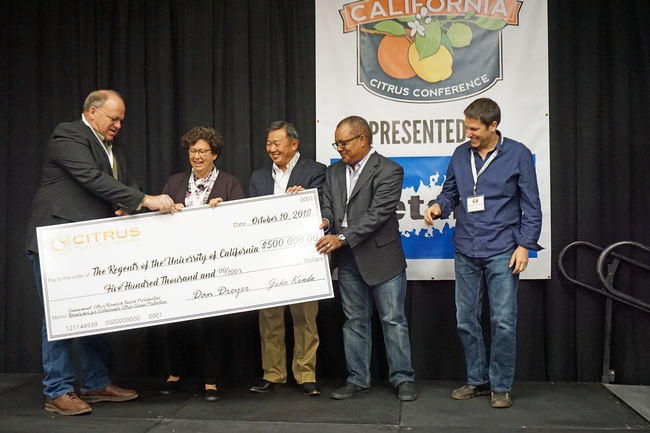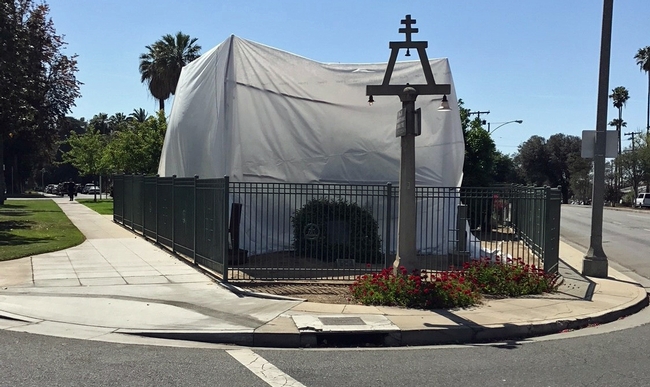Posts Tagged: Georgios Vidalakis
The Citrus Research Board and UC create a $1 million endowment for citrus research
The Citrus Research Board and UC Agriculture and Natural Resources have established a $1 million endowment to fund the Presidential Researcher for Sustainable Citrus Clonal Protection at the UC Lindcove Research and Extension Center. The endowed researcher will provide a UC Cooperative Extension scientist a dedicated source of funds to support scholarly activities focused on the long-term sustainability of the citrus industry.
“I wish to thank the Citrus Research Board for establishing the Presidential Researcher for Sustainable Citrus Clonal Protection at LREC endowment,” said UC ANR vice president Glenda Humiston. “This gift, coupled with the $500,000 match from the UC Office of the President, will help to ensure the long-term success of exemplary research focused on the California citrus industry.”
UC President Janet Napolitano provided half the funds for the endowed researcher; the CRB donated the other half.
“We are gratified that President Napolitano has selected the CRB for this prestigious match program,” said CRB Chairman Dan Dreyer. “It will be invaluable in helping us to pursue critical research that will yield beneficial findings to support the sustainability of the California citrus industry.”
The new endowment supports the UC Citrus Clonal Protection Program, which distributes pathogen-tested, true-to-type citrus budwood to nurseries, farmers and the public to propagate citrus trees for commercial and personal use. The CCPP maintains blocks of trees that serve as the primary source of budwood for all important fruit and rootstock varieties for California's citrus industry and researchers.
The CCPP is a cooperative program between UC ANR, CRB, the California Citrus Nursery Board and the California Department of Food and Agriculture. CCPP director Georgios Vidalakis, UC Cooperative Extension specialist in plant pathology at UC Riverside, shared his appreciation for the efforts that led to the creation of the new endowed researcher position.
“My thanks to the citrus growers for their decades-long support, especially the members of the CCPP committee of the CRB for their vision, and UC's Greg Gibbs for coordinating all of the efforts,” he said. Vidalakis also praised Lindcove director Elizabeth Grafton-Cardwell “for making the case to our growers about the importance of this endowment and for making plans to house the UC ANR endowment at the LREC.”
A selection committee will award the endowment to a distinguished UC ANR academic. An annual payout will be used to provide salary, graduate student and/or program support. The researcher will be named for a five-year term. At the end of that period, the appointment will be reviewed and either renewed or taken back to a selection committee to choose another UC ANR academic.
“I would like to thank the CRB for this generous gift and their continued support of our research for CCPP at the LREC,” said UC ANR Director of Major Gifts Greg Gibbs.
The CRB administers the California Citrus Research Program, the grower-funded and grower-directed program established in 1968 under the California Marketing Act as the mechanism enabling the state's citrus producers to sponsor and support needed research. More information about the Citrus Research Board may be found at www.citrusresearch.org.
The Presidential Researcher for Sustainable Citrus Clonal Protection is the fifth $1 million UC ANR endowment to support California agriculture. The other endowments are:
- UC Cooperative Extension Presidential Chair for Tree Nut Genetics, formed with the California Pistachio Research Board in October 2015
- UC Cooperative Extension Presidential Chair for Tree Nut Soil Science and Plant Water Relations, formed with the California Pistachio Research Board in October 2015
- UC Cooperative Extension Presidential Chair for California Grown Rice, formed with the California Rice Research Board in September 2016
- UC Cooperative Extension Presidential Chair for Agricultural Education in Orange County, formed with the Orange County Farm Bureau in October 2017
City of Riverside tents iconic tree to protect it from huanglongbing disease
The city of Riverside pitched a white tent over the "Parent Navel" orange tree at the intersection of Arlington and Magnolia avenues last week to protect it from the threat of huanglongbing disease, reported Ryan Hagen the Riverside Press Enterprise.
“The Parent Navel is an iconic symbol of Riverside, as it represents the impact the citrus industry had on our economy,” Mayor Rusty Bailey said in a press release issued by the City of Riverside. “Riversiders hold this symbol of our citrus heritage very dear, so it is encouraging to see our parks personnel taking a proactive approach.”
The tree was one of two planted by Eliza Tibbets in 1873, when she received the seedless orange cultivars from Florida by mail. Tibbets cared for the trees and sold budwood to nurseries, which led to extensive plantings of nursery trees cloned from hers.
Huanglongbing disease made its appearance in Riverside last year in residential trees. Officials are working to prevent its spread by controlling Asian citrus psyllid, the insect that can move the disease from tree to tree. Meanwhile researchers are searching for a cure.
The Parent Navel's high value led UC Riverside researchers and city officials to construct the large white barrier.
"It's not beautiful," said Georgios Vidalakis, UC Cooperative Extension specialist and director of the citrus clonal protection program at UC Riverside. "It's obstructing the tree from public view, and we apologize for that. But the risk from not doing that is catastrophic."
143-year-old Washington navel mother tree gets special care
The mother of millions of navel orange trees around the world, a 143-year-old Washington navel orange tree in Riverside, is carefully protected by UC scientists and the Riverside parks department, reported Suzanne Hurt in the Riverside Press-Enterprise.
"We're not going to let this tree die," said Georgios Vidalakis, UC Cooperative Extension specialist in the Department of Plant Pathology at UC Riverside. Vidalakis is the director of the UC Citrus Clonal Protection Program.
Scientists protect the tree using special tools, insecticides and disease monitoring.
According to legend, the seedless and sweet Washington navel was an accidental mutant that appeared on the grounds of a Brazil monastery in the early 1800s. Tree clones were sent to USDA in Washington, D.C., and from there acquired by Eliza Tibbets, who tended the trees at her home in Riverside.
"Producing budding stock to make other saplings, Tibbets' trees birthed a citrus industry dubbed California's second gold rush," the Press-Enterprise story said.
John Bash, a UC Riverside staff researcher who worked with the Washington navel for 32 years, called the mother tree "one of the world's agricultural icons."
"There are literally millions and millions of trees that can trace their ancestry back to that single tree," Bash said.



